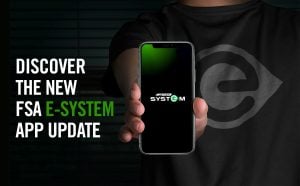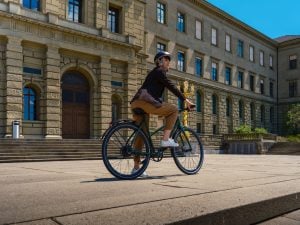
Discover NOKOMAGMA: the new Gravel e-bike that redefines cycling on mixed terrains
The world of pedal-assist bicycles continues to amaze with increasingly advanced innovations, and NOKO is no exception. We are thrilled to introduce our latest model:

EUROPE Free Shipping

Delivered fully assembled
fully assembled
100% made in italy
The first step to understanding how e-bikes work is to know the parts that make up the e-system, which allows you to activate the pedal assistance. But more important is knowing how to use an e-bike correctly, to preserve the correct functioning of the components over time. This guide is addressed to you who are approaching an e-bike for the first time, as to you who have bought or would like to buy a NOKO. In this article, we will reveal everything you need to know about NOKO e-bikes and their correct use.
The heart of NOKO e-bikes is the FSA e-system. It’s an e-system very simple and intuitive, and you will manage it through a single multifunctional LED button. The FSA e-system is made up of three components: the rear hub motor, the battery, and the On-Off button.

As with most e-bikes, to start the system – and then activate the pedal assist – just press the power button for one second. The button is on the top tube of your NOKO and provides all the information you need to know the state of charge and the active assistance level. Remember to disable assistance when you return from your ride with NOKO. Again, you will simply have to press the button until a white light indicates the shutdown.
Through a nice system of color lights, you can also know the status of the battery and the level of assistance you are using. With the system active, while you are driving or even stationary, you will see two colored lights alternating on the LED button. One light is steady (state of charge) and one is flashing (level of assistance). Here are the color summary tables that we advise you to keep in mind!

State of charge (flashing light)

Assistance levels (steady light)
Also using the power button, you can select one of the 5 levels of assistance you want. The assistance of the motor is gradual: as you increase the level, the power delivered increases. In other words, it means that using the ECO level the e-bike motor will deliver minimal torque, and you will have to rely more on the strength of your legs. On the contrary, in Boost mode you get maximum assistance (43 Nm), speeding at 25 km / h in no time!
There is no rule that establishes which level of assistance to set. You decide, based on the characteristics of the route and your needs. Our advice is to choose assistance based on the nature of the route: for example, if you are traveling on a flat and smooth path, you can opt for less assistance while consuming less energy. But how to save on the battery is a point that we will discuss in the next points. For a more detailed explanation, please consult our NOKO User Manual.
The battery is the “heart” of an e-bike and requires particular attention during use and maintenance. Charging the e-bike battery is a very simple routine operation, but you need to make sure you do it correctly to keep it functioning correctly over time. But what is the average life of a NOKO e-bike battery? Typically, 500 charging cycles are guaranteed. However, the use of the battery over time leads to inevitable and natural wear, not guaranteeing its capacity at 100%. Also, improperly charging your e-bike will significantly reduce battery performance. Here are the instructions and some of our tips to keep in mind.

To charge your NOKO e-bike, connect it with the power supply to any electrical outlet. The 252 Wh battery is integrated into the frame, so you don’t have to take it out to charge. The charging port is located at the lower end of the down tube and is covered by a protective cap.
The time for a full charge is about 4 hours for an average duration of about 100 km. However, the range can drop to 60-70 km depending on some factors: level of assistance, type of route, rider’s weight, etc. In general, it is not necessary to wait for the battery to discharge completely before recharging. If the battery level is low, you can proceed with a new charge without the risk of compromising the battery itself.
To increase autonomy, alternate the assistance levels, avoiding keeping the Boost level active if not necessary. Or, whenever possible, prefer flat routes to uphill sections, using less or Eco assistance.
Calculate the length of your route in advance and check the battery status before jumping on the saddle! For rides over 100 km long, we recommend that you equip yourself with the Range Extender, doubling the range to 200 km. Alternatively, you can take the battery charger with you and use the columns to recharge your e-bike. If the battery runs out along the way and you can’t recharge it, you can safely cycle with the motor off just like a muscular bike. This is because the FSA hub motor features minimal friction and drag in the drivetrain, allowing you to pedal in a very natural way.
Use the original charger to guarantee efficient recharges and avoid possible damage. If you plan not to use the bicycle for more than 2-3 months, we recommend that you store it indoors with a charge between 30% and 60% (blue or yellow light). Check the e-bike battery status regularly (approximately every 3-6 months) and, if necessary, charge it to maintain these levels.
Last but not least, we recommend that you do not recharge the e-bike battery immediately after using your NOKO. Wait a few moments to give the battery time to cool down and avoid overheating.


Discover NOKOMAGMA: the new Gravel e-bike that redefines cycling on mixed terrains
The world of pedal-assist bicycles continues to amaze with increasingly advanced innovations, and NOKO is no exception. We are thrilled to introduce our latest model:
NOKO at Blechexpo 2023: E-Bike Showcase in Stuttgart from November 7th to 10th
The NOKO e-bikes are making their debut at the 16th edition of the Blechexpo Trade Fair, a significant event in the world of sheet metal

The Future Is Here: Explore the Latest FSA SYSTEM App Update
We are pleased to introduce the latest update of the FSA SYSTEM App, which will make your adventures with NOKO more extraordinary! The main goal

How to choose the right size for your NOKO e-bike
Choosing the right size for your e-bike is crucial to ensure a comfortable, efficient, and safe riding experience. One of the most frequently asked questions
Explore
About Us
Help
TRAFIME SPA – Misterbianco (Italy) Capitale sociale € 15.780.000 i.v. – P.I. 00875480873
TRAFIME SPA – Misterbianco (Italy)
Capitale sociale € 15.780.000 i.v. – P.I. 00875480873